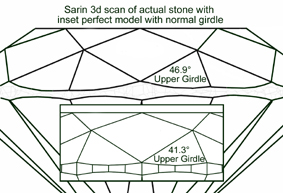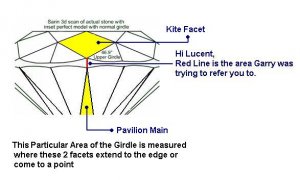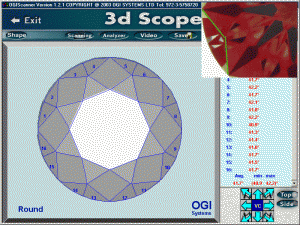I am trying to understand the light return analysis used in GoodOldGold website. So far, I am really confused. I pick these 2 stones from GOG website as an example. They both 1.25 Carat, and have the same color so it's easy to compare.
The problem with buying on the Internet is that you don't see the diamond in person. I would not buy stone A for it's Brilliant Scope reading and would not buy stone B for its Lightscope reading.
Can some expert and maybe Johnathan comment on the Brilliant Scope reading and especially the light scope images. Can you tell the different between these 2 stone in term of visual performance?
Looking at the light scope, Stone A light scope image is very round and red while stone B has white V shapes. Stone B also has more black (especially between the arrows) Does this mean that stone B has more fire and stone A is more brilliant?
Stone A: http://www.goodoldgold.com/1_25ct_f_si1_h%26a.htm
1.25, F, SI1
BS: Medium, Very High, Medium
Isee2: 9.8/10

Stone B: http://www.goodoldgold.com/1_250ct_f_vs2__h%26a.htm
1.25, F,VS2
BS: High, Very High, High
Isee2: 9.6/10

Note: The background is darker on this stone
Thank you in advance for all your comment.
The problem with buying on the Internet is that you don't see the diamond in person. I would not buy stone A for it's Brilliant Scope reading and would not buy stone B for its Lightscope reading.
Can some expert and maybe Johnathan comment on the Brilliant Scope reading and especially the light scope images. Can you tell the different between these 2 stone in term of visual performance?
Looking at the light scope, Stone A light scope image is very round and red while stone B has white V shapes. Stone B also has more black (especially between the arrows) Does this mean that stone B has more fire and stone A is more brilliant?
Stone A: http://www.goodoldgold.com/1_25ct_f_si1_h%26a.htm
1.25, F, SI1
BS: Medium, Very High, Medium
Isee2: 9.8/10

Stone B: http://www.goodoldgold.com/1_250ct_f_vs2__h%26a.htm
1.25, F,VS2
BS: High, Very High, High
Isee2: 9.6/10

Note: The background is darker on this stone
Thank you in advance for all your comment.











300x240.png)